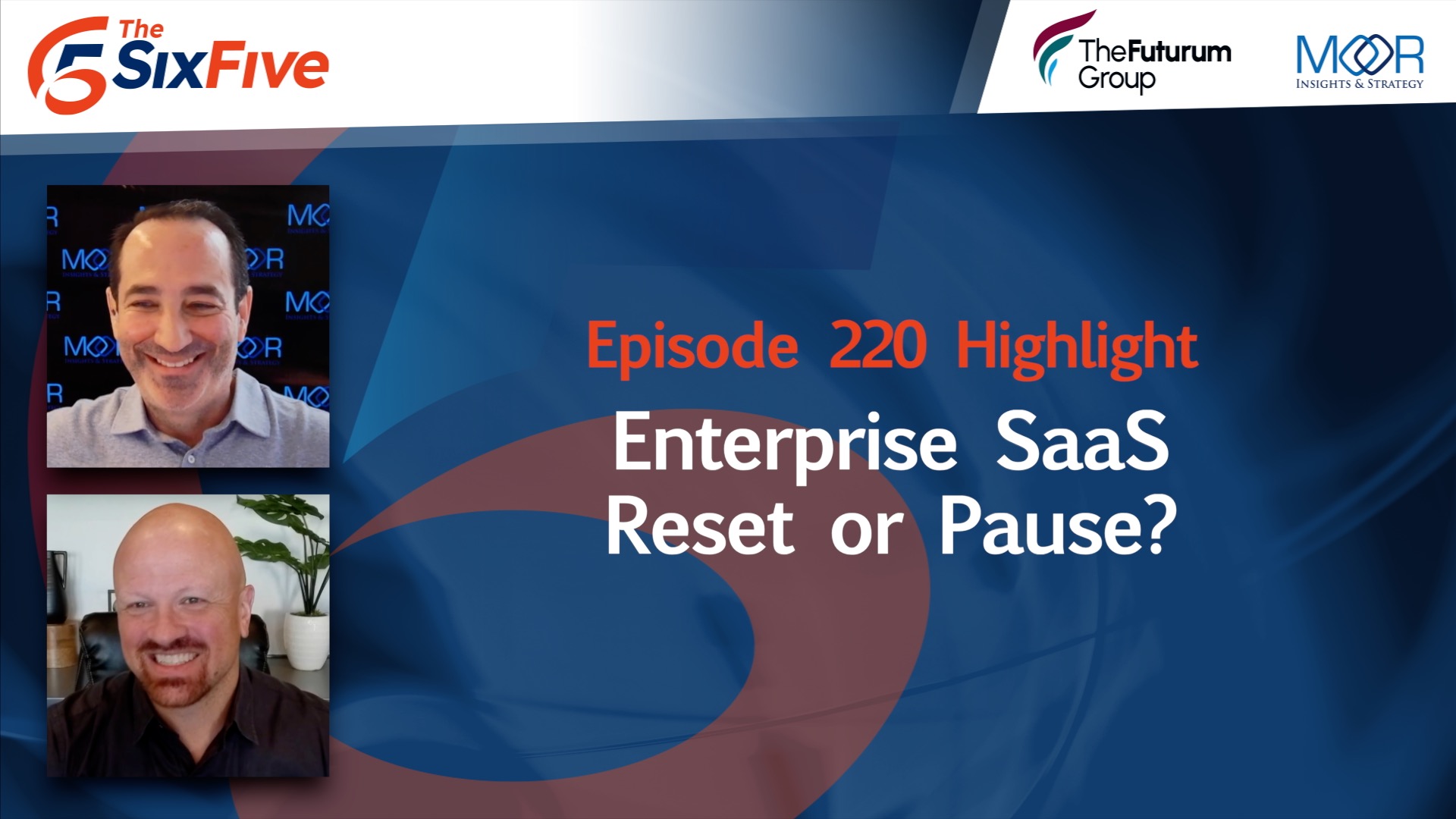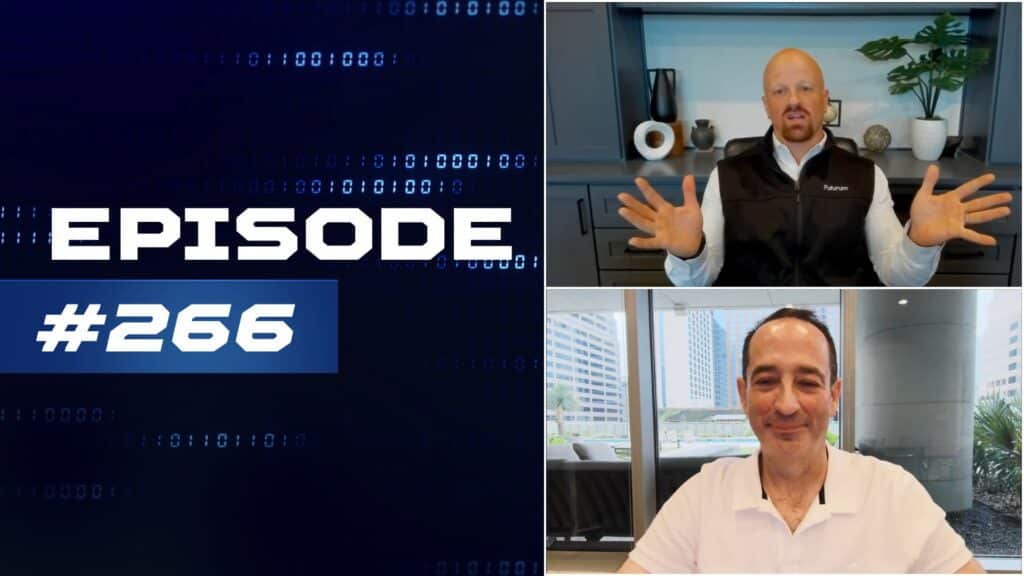The Six Five team discusses enterprise SaaS reset or pause?
If you are interested in watching the full episode you can check it out here.
Disclaimer: The Six Five Webcast is for information and entertainment purposes only. Over the course of this webcast, we may talk about companies that are publicly traded and we may even reference that fact and their equity share price, but please do not take anything that we say as a recommendation about what you should do with your investment dollars. We are not investment advisors and we ask that you do not treat us as such.
Transcript:
Patrick Moorhead: Hey, I want to bounce to a really provocative conversation that you have been very public with, some pretty long posts. Let me read some of the stuff you said. Software and SaaS have been under fire, but the market was also quick to recognize a good result based on Adobe. But before that, you had a very long post. In fact, you had a long post alert out there based on what Salesforce had brought out, and you had ended it with saying, “Is the SaaS bubble bursting?” So hey, let’s dive in here. Is software and enterprise SaaS dead, Daniel?
Daniel Newman: Well, like I said, it was nice that we sort of started this because we had a couple of software companies to talk about, but Salesforce reported a guidance of under 10% and the market just absolutely pummeled every software company for it. You saw 10+ percent drops, and these are not companies that are used to that kind of volatility. These are companies that typically move a lot slower because they have high ARR, high predictable revenue, consistent margins, steady growth rates.
And of course, when you look at these projections on revenue, these are real solid companies. Benioff, for instance, over at Salesforce, Marc Benioff, CEO of Salesforce, had made a lot of what I would call the operational cuts that were needed to be made. They got a little financially overburdened during COVID, that started driving down APS, growth was slowing a little bit. Enterprise software, to your point, can have long cycles and the AI trend has been a bit opaque to the market as to whether people are paying for Genie. Is it a value add?
This is the question mark to ask, Pat, is AI incremental or is AI a requirement to keep your customers? Because new technologies are going to come out that people are going to be able to get access to AI more simply. This is what my conversation during The Six Five Summit with Bill McDermott was all about single pane of glass abstraction. Do all these different tools eventually just become databases? And then one sort of pane of glass can basically look across all of the systems and then provide insights rendered with gen AI? I mean literally, because you can render an interface with gen AI that could then just basically, just like right now we’re doing with OpenAI on ChatGPT, it looks across everything and then renders text. Well, could you render imagery? Could you render a forecast? Can you render… And we’re already seeing that sort of happening.
So then the questions come down to how quickly does this happen? Who’s the right company to do it? Is this really possible when you have data that isn’t all public? So what ChatGPT does with publicly available data is very different than dealing with on-prem, in the cloud, private data with different sovereignty, different data provenance, that has to be dealt with, residency. And so it’s not that easy. It’s not going to be as easy as just like, “Hey, we’re just going to look at all these different software. You’re going to look at your ERP, your CRM, your SCM, your HCM, and all these tools together and you’re just going to query it and you’re just going to get this awesome visual.” But that is ultimately where we want to go. So who are the best companies to ultimately serve this market? And it’s the consumption layer, Pat, and software is the consumption layer.
So is it everybody? I don’t know that it’ll be everybody, but core companies like Salesforce, SAP, Oracle, Workday, ServiceNow, they’re in a really good position. You’re talking about companies with 100,000+ customers that are on subscriptions that have made massive investments to deploy these softwares in their businesses. You and I have done it. We’ve already seen, even in the smaller businesses, how sticky this stuff is. And so will we pay $10 or $15 or $20 a month more to get crazy capabilities and generative tools? And the answer I think ultimately is yes. I think incrementally we are going to spend more to get access to AI inside of the tools that we already have that allow us to start enjoying the benefits of AI immediately.
So, I think the market is sort of messed up right now. We look at companies that have five customers making 50% of their revenue because we see the infinite value of training models, which is important and necessary, but I think there’s much more risk there of competition, there’s risk of margin erosion, there’s risk of supply chain. There’s a lot of reasons to like a company like Oracle, like Adobe, like Salesforce, that have a huge customer base that are captive users that want AI capabilities and are probably willing to pay something for them, but the market hasn’t shaken out how much they’re willing to pay and until they do, I think there’s risk.
And I think, of course, there is the disruptive risk of new companies come in, using gen AI, streamlining data. But remember, cloud is, you like to say, Pat, a teenager, for almost two decades, companies have tried to bring databases together and have not so far succeeded in doing that in a single streamlined pane of glass. And until they can, we’re not going to be able to do gen AI either.
Patrick Moorhead: Yeah. So that was a good 10-minute analysis, Dan. It was good-
Daniel Newman: It was like six at the most. Sorry.
Patrick Moorhead: So, here’s my take. My take is that if I look at some of the biggest transitions that we’ve had, which was on-prem to internet, and by the way, Salesforce was an internet company, client server, enterprise SaaS, public cloud, social local mobile, there’ve been big changes. And what happens is there’s a lot of churn and then people stop buying everything because there’s too many choices. And right now, look at the choices to fulfill what maybe the enterprise SaaS folks are doing.
First of all, you have companies like ServiceNow who have this experience layer that can cut across that says, “Hey, just give me access to the application. Don’t upgrade the application, but pay me to be the experience layer.” That’s one. Then you have the horizontal folks, Google agents, you have Microsoft Co-pilot, you have Amazon Q that are talking about the same type of capability, “Hey, put this layer on top and make this happen.” And then you’ve got budgetary challenges, which are infrastructure and GPUs that could be taking away from some of these deals. So, to me, this is a wrestling match, very similar to what we’ve seen in the prior historical inflection points, and it’s going to be up to the Oracles, the Salesforces, the Adobes to make their value proposition just simple.
The final thing that we have a delay on is because of the data. The reason why Marc Benioff on all his earnings calls talks half about data is because that is the technological challenge and also the challenge from a security and privacy and “safe” AI
Author Information
Daniel is the CEO of The Futurum Group. Living his life at the intersection of people and technology, Daniel works with the world’s largest technology brands exploring Digital Transformation and how it is influencing the enterprise.
From the leading edge of AI to global technology policy, Daniel makes the connections between business, people and tech that are required for companies to benefit most from their technology investments. Daniel is a top 5 globally ranked industry analyst and his ideas are regularly cited or shared in television appearances by CNBC, Bloomberg, Wall Street Journal and hundreds of other sites around the world.
A 7x Best-Selling Author including his most recent book “Human/Machine.” Daniel is also a Forbes and MarketWatch (Dow Jones) contributor.
An MBA and Former Graduate Adjunct Faculty, Daniel is an Austin Texas transplant after 40 years in Chicago. His speaking takes him around the world each year as he shares his vision of the role technology will play in our future.





